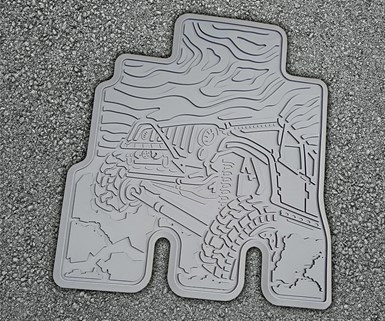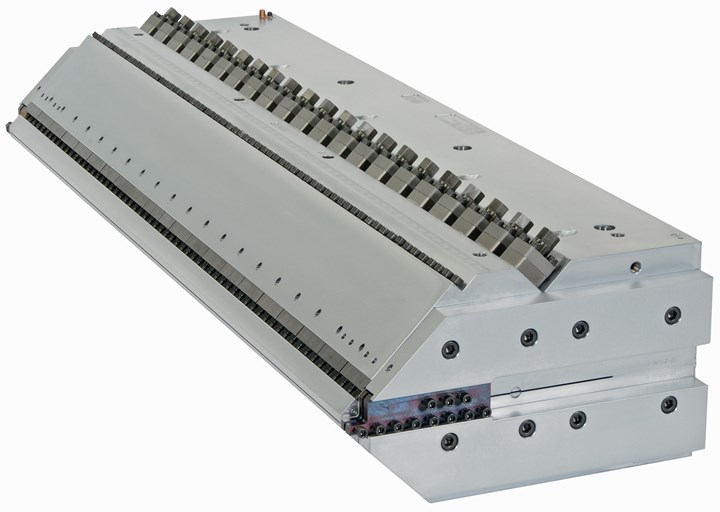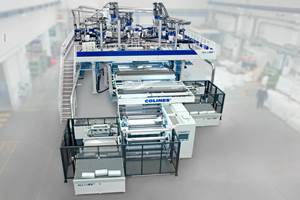Auto Interiors Leader Brings Extrusion In-House
For first time in its 35-yr history, Legendary Auto Interiors is producing its own PVC sheet for floor-mat line.
A firm that for more than 35 years has helped owners of classic cars restore their vehicles’ interiors to as-new condition has made its first venture into extrusion processing. About a year and a half ago, Legendary Auto Interiors Ltd., Newark, N.Y., worked with Nordson Corporation’s EDI team on the installation of its first sheet extrusion line. The sheet line supports an undisclosed number of thermoforming machines at the firm, and plans are already on the drawing board to add more extrusion capacity.
Since its founding in 1983 by owner Martin Beckenbach, Legendary Auto Interiors (legendaryautointeriors.com) has produced hundreds of thousands of soft-trim components designed for retrofitting hundreds of vintage models, including many American “muscle cars” from the 1960s through the 1990s. Ranging from door panels and sun visors to upholstery and carpets, many of these components are cut, sewn, and thermoformed in-house at Legendary’s headquarters.
Until now the company relied on outside firms to supply flexible PVC sheet for its floor-mat lines.“We have had 30 years of experience in cutting, sewing, and thermoforming, but none in sheet extrusion,” says Beckenbach. “The Nordson team played a critical role in helping us get up to speed and manufacture vinyl sheet that perfectly meets our requirements.”
The extruder, a 3.5-in. Polytruder, was refurbished. Beckenbach says the rebuild included all electrical, electronic, and mechanical components, among them a multi-purpose mixing screw and new 100-hp AC motor and drive.

Legendary Auto Interiors makes a range of floor mats, such as this Jeep mat.
Downstream, the firm restored in-house an old Johnson 54-in. system. States Beckenbach, “Every nut and bolt, the AC motors and drives, gears and gear boxes, chains, wiring, air and hydraulic systems, and heating/cooling system have been replaced or rebuilt with new. The roll stack, pull nip and winder have been restored. The cooling table, gantries and exhaust ventilation system were custom built to our requirements. Roll-stack rolls have been restored inside and out and rechromed.”
The EDI Ultraflex sheet die was bought new and equipped with a restrictor bar to enhance control of sheet uniformity. Nordson dispatched an EDI team to provide start-up service, including hands-on training for how to operate the die, make adjustments, perform maintenance, and ensure operator safety.
Legendary Auto Interiors runs flexible PVC sheet 55-in. wide (usable 53.5 in.) at varying thickness from 0.030 to 0.1875 in. Nordson was there when the system was first fired up. Recalls Rick Crank, Nordson service technician, “Once the die was installed, we showed the Legendary Auto Interiors team how to heat the die properly to drive the moisture out of the heaters and then start up the extrusion line to purge remnant polymer through the system. After we explained how to adjust the die and zone temperatures to control the quality and thickness of the sheet product, the Legendary operators produced quality sheet within the desired tolerance.”

Legendary Auto Interiors equipped its first-ever sheet extrusion line with EDI’s Ultraflex Die. The die has a restrictor bar to enhance quality control.
A key part of the start-up training involved taking full advantage of the restrictor bar, which is inside the die but is externally adjustable. Nordson equips sheet dies with restrictor bars for product thicknesses above 80 mils, notes James Winning, Nordson’s regional sales manager. “Along with the flexible upper lip that is standard with EDI extrusion dies, the restrictor bar is used to adjust the thickness profile across the width of the die,” says Winning. “One of its benefits is to ensure uniformity in the melt-bank flow just before the nip point between the rolls. This uniformity reduces operational expenses and material consumption, preventing loss of material caused by surface irregularities.”
Beckenbach is pleased with the results. “The restrictor bar is working absolutely perfectly. It is so easy to use, and I can control the bank flow with perfection,” he states.
Legendary Auto Interiors is using the extrusion line with the new Ultraflex die to produce its next-generation floor mats, along with custom vintage floor mats. In addition, the new extrusion capability will be used to manufacture various gauges of sheet for many other sewn, heat-sealed, and thermoformed products.
Related Content
Formulating LLDPE/LDPE Blends For Abuse–Resistant Blown Film
A new study shows how the type and amount of LDPE in blends with LLDPE affect the processing and strength/toughness properties of blown film. Data are shown for both LDPE-rich and LLDPE-rich blends.
Read MoreSolve Four Common Problems in PET Stretch-Blow Molding
Here’s a quick guide to fixing four nettlesome problems in processing PET bottles.
Read MoreUS Merchants Makes its Mark in Injection Molding
In less than a decade in injection molding, US Merchants has acquired hundreds of machines spread across facilities in California, Texas, Virginia and Arizona, with even more growth coming.
Read MoreYoung Stretch-Film Processor Bets on Nanolayers
Going up against companies with as much as double its capacity, young stretch-film processor Zummit believes that new technology — notably 59-nanolayer films — will give it a competitive edge.
Read MoreRead Next
Advanced Recycling: Beyond Pyrolysis
Consumer-product brand owners increasingly see advanced chemical recycling as a necessary complement to mechanical recycling if they are to meet ambitious goals for a circular economy in the next decade. Dozens of technology providers are developing new technologies to overcome the limitations of existing pyrolysis methods and to commercialize various alternative approaches to chemical recycling of plastics.
Read MoreWhy (and What) You Need to Dry
Other than polyolefins, almost every other polymer exhibits some level of polarity and therefore can absorb a certain amount of moisture from the atmosphere. Here’s a look at some of these materials, and what needs to be done to dry them.
Read More
























